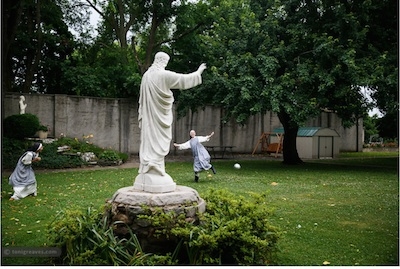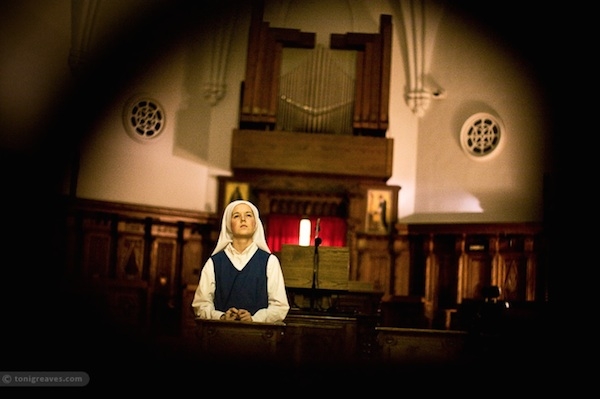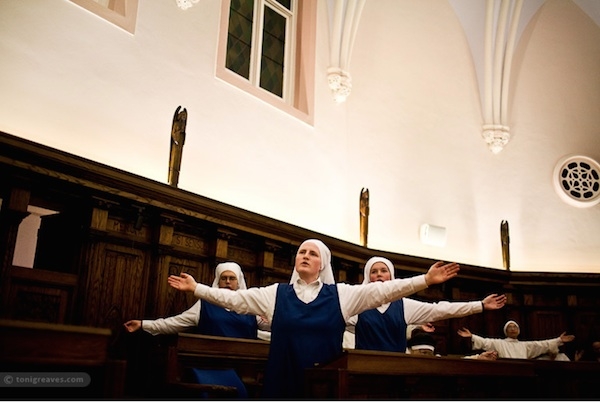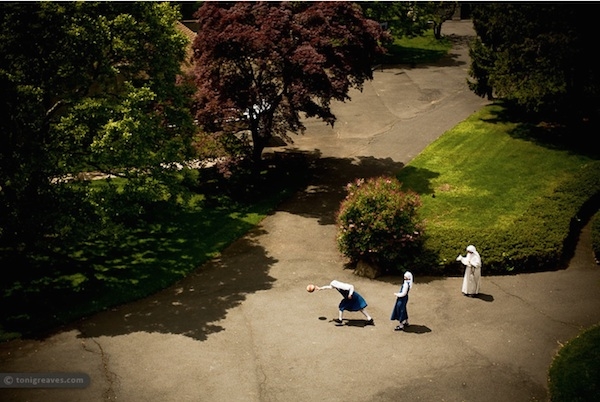Photographer Profile - Toni Greaves: "Photography is my spiritual pursuit"

|
|
|
“I was like, ‘No, I think I’m good with photography. Photography is my spiritual pursuit,’” she recalls.
Greaves wasn’t being entirely facetious.
She began photographing at the monastery in 2008, when she was still a photography student at the International Center of Photography. Greaves says she came to the project, in part at least, as a response to the death of her mother in 2004. “I started being very curious about who and what we are, outside of our physical bodies, and I became interested in dedicated spiritual communities,” she says. “I thought that these enclaves created a potential of concentrated connection in that way for people.”
In fact, says Greaves, it was the death of her mother that led her to take up photography. A native of Australia who moved to the US in the early 1990s, she left a career as a graphic designer to enroll at ICP in 2006, on the second anniversary of her mother’s death. “I’d always loved photography, so I decided to focus on what made me happy,” she says.
At the monastery, Greaves came to see the decisions that the nuns had made about their lives in a similar light.
“For many people, it might be hard to imagine living away from the world, as they do, but what struck me was the sense of joy I felt there,” she says. “There’s something about how the nuns focus on what they love most in life. In the world outside the monastery, we are so often burdened by everything we have to do. We have to make an effort to put those things aside and to find the core things that we love in life. And it can be a struggle at times. The nuns have the ability to limit those distractions by the choice of being inside this closed community.”

Greaves has now collected her work from the monastery in the book Radical Love. In a sense, the book marks the end of a memorable period in her life — a period she never planned on. “I didn't start out thinking I was going to spend eight years working on this project,” she says. “It was just one thing leading to another, and you piece it all together as you go along.”
She doesn’t see the book as an ending, though. Rather, she calls it a “punctuation point” — a culmination, but not a conclusion. Documentary photographers who have immersed themselves in stories over long periods and established close ties to their subjects will understand what she means.
“What is concluding?” Greaves asks. “I don’t really know.”
Putting Subjects First
Founded in 1919, the Dominican Monastery of Our Lady of the Rosary sits on a small hill in Summit, across the street from a gas station. At any given moment there may be 20 or so nuns living there. “It’s this secluded world in the middle of this little town,” says Greaves.
Her work at the monastery began as a school assignment, when she was teamed with a writer who was was looking into a story about how the Internet was being used to recruit nuns. “I went along to provide some visuals. Once I was there, I became intrigued and just kept coming back,” she says.
Greaves would stay at the monastery for several days at a time, sleeping in a guest room. Normally, the door connecting the room with other parts of the monastery is kept locked. When Greaves stayed at the monastery, it was left unlocked, allowing her complete access to the nuns’ private spaces.
“How I make myself welcome is by not trying to make myself welcome,” she says. “I put my subjects first — I care about them more than the photos. Although that comes from a genuine human place, I think it helps me gain a lot of trust.”
Consequently, Greaves’s photographs are intimate, detailed and graceful.
“I prefer to be very minimalist, shooting everything in natural light,” she says. “I don’t carry a lot of gear. It will be me and my camera with a lens on it.”

On her first visit, Greaves met Sister Lauren, a 21-year-old novice who became an early subject. “To look at this person who is so young, who has made the decision to close herself off from the world for the rest of her life — it’s amazing. Most of us go fumbling through life trying to figure out what we want. At that age I had no idea what I wanted to do,” she says.
Her project also focused on the older nuns at the monastery. Early on, Greaves met Sister Mary Peter, an older nun who liked roses. “One time I randomly brought a rose to give to her. She got such joy and giddiness over that rose that it got to be a thing, and I would bring roses whenever I went there,” she says.
She also brought fresh vegetables. “The nuns have a garden now,” she says, “but early in the project I noticed that they weren’t eating many fresh greens, so I’d come with big bags of kale and other vegetables.”
While staying at the monastery, Greaves would rise at 5:20 in the morning, when the nuns gathered for prayer. For the rest of the day, she would follow them through their studies, meditations, and various tasks. “I was struck and also inspired by their will and dedication,” she says. “There was a kind of fortitude I admired.”
A Sense of Peace
In 2009, Greaves relocated from New York to Portland, Oregon, where she began pursuing her documentary career outside the closed world of the Dominican Monastery of Our Lady of the Rosary. Between working on editorial assignments for the New York Times Magazine, Le Monde, the Wall Street Journal and Marie Claire and commercial jobs for a variety of companies, she would fly back to the East Coast to continue her project on the monastery.
It was a matter of finishing the work, and exploring the world of the nuns more deeply.
“In my work, I would like people to look at who the nuns are as a people,” Greaves says. “Maybe you’re not Roman Catholic, or maybe you don’t believe in God, but does that matter? Can you see these people and value them and their lives for the beautiful thing it is, even though it might be different from yours?”

Working on the project for so long allowed Greaves to not only witness, but to also be a part of the lives of the nuns in the monastery. Over the eight years, several of the older nuns she photographed passed away, including Sister Mary Peter, who loved roses. Greaves photographed Sister Lauren from the day she took her religious name, Sister Maria Teresa, to the day she took her final vows.
“I found a sense of peace being there,” she says. “In the earlier years, I was going through a lot personally, adjusting to my life without my mother. I gained and continue to gain a lot from the openness and friendship of the nuns,” she says.



